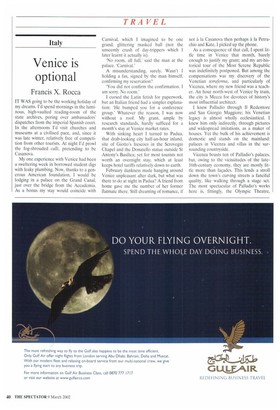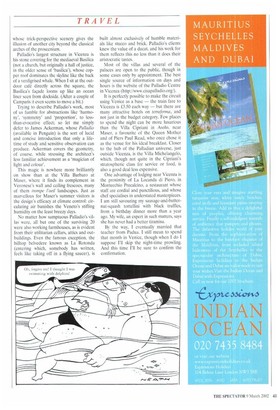Venice is optional
Francis X. Rocca
IT WAS going to be the working holiday of my dreams. I'd spend mornings in the luminous, high-vaulted reading-room of the state archives, poring over ambassadors' dispatches from the imperial Spanish court. In the afternoons I'd visit churches and museums at a civilised pace, and, since it was late winter, relatively free of competition from other tourists. At night I'd prowl the fog-shrouded calli, pretending to be Casanova.
My one experience with Venice had been a sweltering week in borrowed student digs with leaky plumbing. Now, thanks to a generous American foundation. I would be lodging in a palace on the Grand Canal, just over the bridge from the Accademia. As a bonus my stay would coincide with Carnival, which I imagined to be one grand, glittering masked ball (not the unseemly crush of day-trippers which I later learnt it actually is).
'No room, all full,' said the man at the palace. 'Carnival.'
A misunderstanding. surely. Wasn't I holding a fax, signed by the man himself, confirming my reservation?
'You did not confirm the confirmation. I am sorry. No room.
I cursed the Latin fetish for paperwork, but an Italian friend had a simpler explanation: 'He bumped you for a conference group.' Whatever the reason, I was now without a roof. My grant, ample by research standards, hardly sufficed for a month's stay at Venice market rates.
With sinking heart I turned to Padua, that drab-looking city half-an-hour inland, site of Giotto's frescoes in the Scrovegni Chapel and the Donatello statue outside St Antony's Basilica; yet for most tourists not worth an overnight stay, which at least keeps hotel tariffs relatively down to earth.
February dankness made hanging around Venice unpleasant after dark, but what was there to do at night in Padua? A friend from home gave me the number of her former flatmate there. Still dreaming of romance, if not a la Casanova then perhaps a la Petruchio and Kate, I picked up the phone.
As a consequence of that call, I spent little time in Venice that month, barely enough to justify my grant; and my art-historical tour of the Most Serene Republic was indefinitely postponed. But among the compensations was my discovery of the Venetian terrafenna, and particularly of Vicenza, where my new friend was a teacher. An hour north-west of Venice by train, the city is Mecca for devotees of history's most influential architect.
I knew Palladio through Ii Redentore and San Giorgio Maggiore; his Venetian legacy is almost wholly ecclesiastical. I knew him only indirectly, through pictures and widespread imitations, as a maker of houses. Yet the bulk of his achievement is domestic and stands on the mainland: palaces in Vicenza and villas in the surrounding countryside.
Vicenza boasts ten of Palladio's palaces, but, owing to the vicissitudes of the late16th-century economy, they are mostly little more than façades. This lends a stroll down the town's curving streets a fanciful quality, like walking through a stage set. The most spectacular of Palladio's works here is, fittingly, the Olympic Theatre, whose trick-perspective scenery gives the illusion of another city beyond the classical arches of the proscenium.
Palladio's largest structure in Vicenza is his stone covering for the mediaeval Basilica (not a church, but originally a hall of justice, in the older sense of 'basilica'), whose copper roof dominates the skyline like the back of a verdigrised whale. When I sit at the outdoor café directly across the square, the Basilica's façade looms up like an ocean liner seen from dockside. (After a couple of Camparis it even seems to move a bit.) Trying to describe Palladio's work, most of us fumble for abstractions like 'harmony', 'symmetry' and 'proportion', to lessthan-evocative effect; so let me simply defer to James Ackerman, whose Palladio (available in Penguin) is the sort of lucid and concise introduction that only a lifetime of study and sensitive observation can produce. Ackerman covers the geometry, of course, while stressing the architect's less familiar achievement as a 'magician of light and colour'.
This magic is nowhere more brilliantly on show than at the Villa Barbaro at Maser, where it finds its complement in Veronese's wall and ceiling frescoes, many of them trompe l'oeil landscapes. Just as marvellous for Maser's summer visitors is the design's efficacy at climate control: circulating air banishes the Veneto's stifling humidity on the least breezy days.
No matter how sumptuous Palladio's villas were, all but one of the surviving 20 were also working farmhouses, as is evident from their utilitarian cellars, attics and outbuildings. Even the famous exception, the hilltop belvedere known as La Rotonda (entering which, somebody has written, feels like taking off in a flying saucer), is built almost exclusively of humble materials like stucco and brick. Palladio's clients knew the value of a ducat, and his work for them reflects this no less than it does their aristocratic tastes.
Most of the villas and several of the palaces are open to the public, though in some cases only by appointment. The best single source of information on days and hours is the website of the Palladio Centre in Vicenza (http://www.cisapalladio.org/).
It is perfectly possible to make the circuit using Venice as a base — the train fare to Vicenza is 13.50 each way — but there are many attractive hotels on terrafenna, and not just in the budget category. Few places to spend the night can be more luxurious than the Villa Cipriani in Asolo, near Maser, a favourite of the Queen Mother and of Piers Paul Read, who once chose it as the venue for his ideal breakfast. Closer to the hub of the Palladian universe, just outside Vicenza, is the Villa Michelangelo, which, though not quite in the Cipriani's stratospheric class for service or food, is also a good deal less expensive.
One advantage of lodging near Vicenza is the proximity of La Locanda di Piero, in Montecchio Precalcino, a restaurant whose staff are cordial and punctilious, and whose chef specialises in understated masterpieces. I am still savouring my sausage-and-butternut-squash tortellini with black truffles, from a birthday dinner more than a year ago. My wife, an expert in such matters, says she has never had a better tiramisu.
By the way, I eventually married that teacher from Padua. I still mean to spend that month in Venice, though when I do I suppose I'll skip the night-time prowling. And this time I'll be sure to confirm the confirmation.















































































 Previous page
Previous page